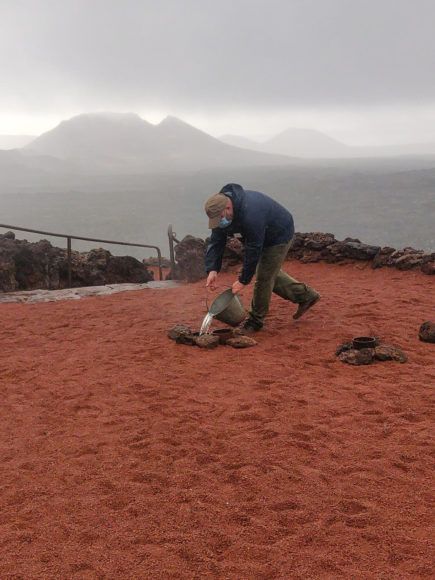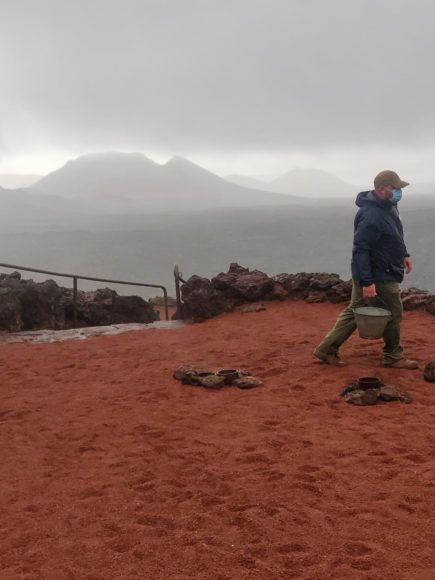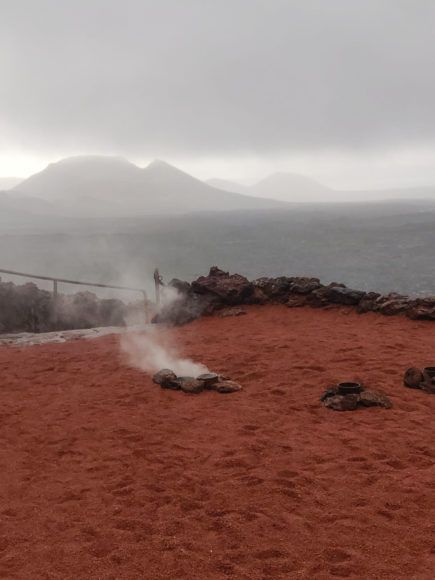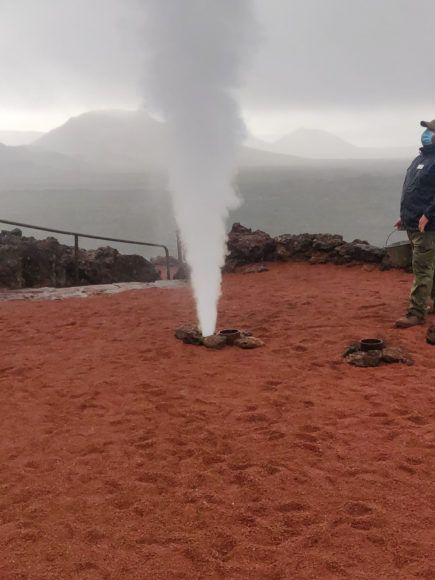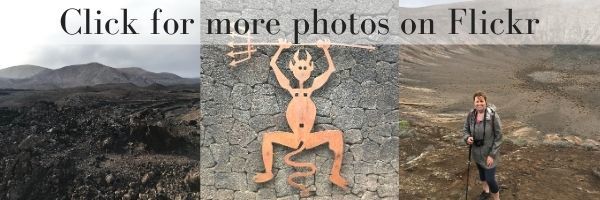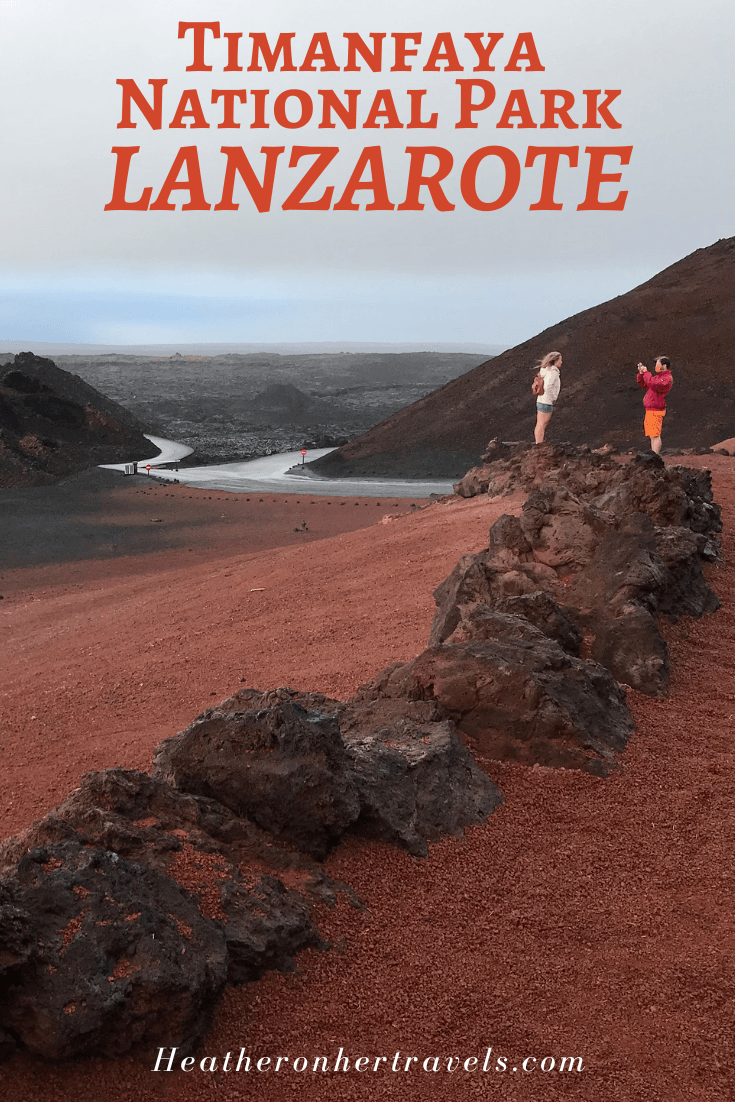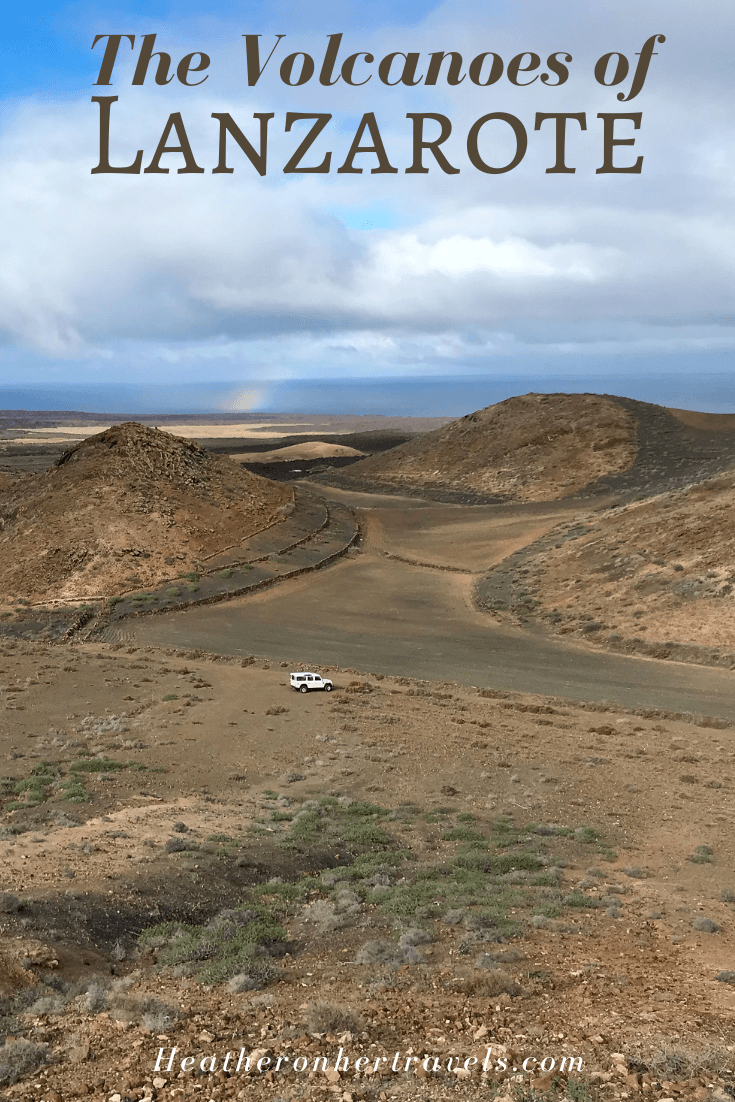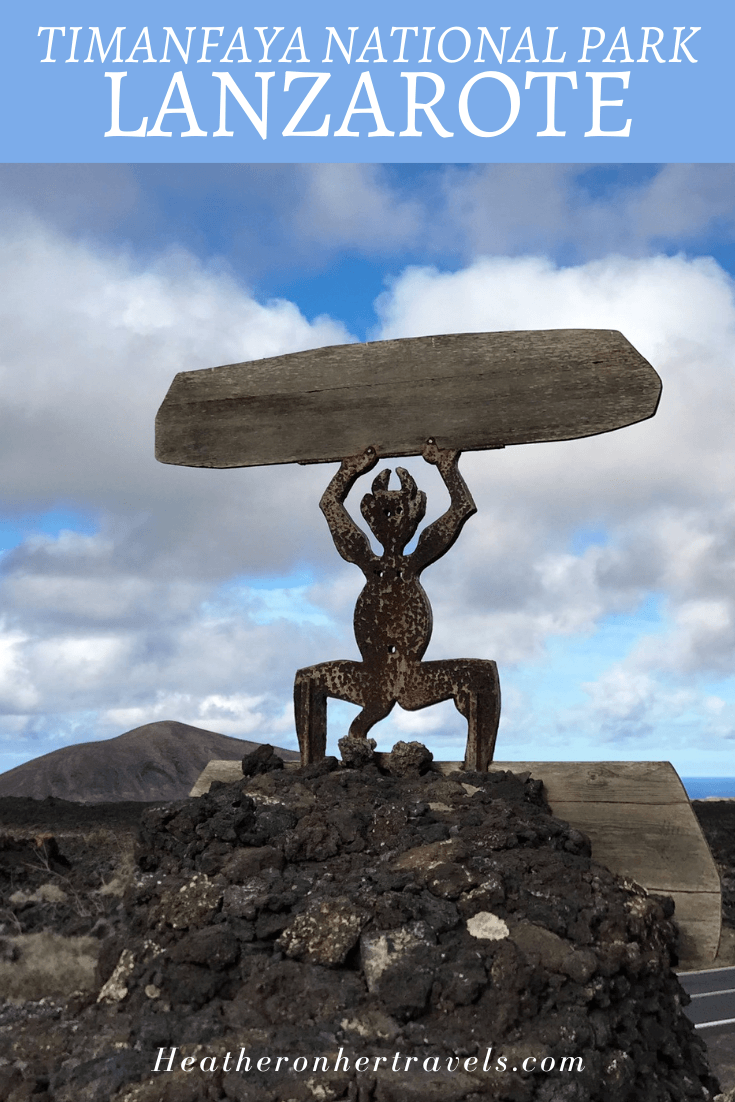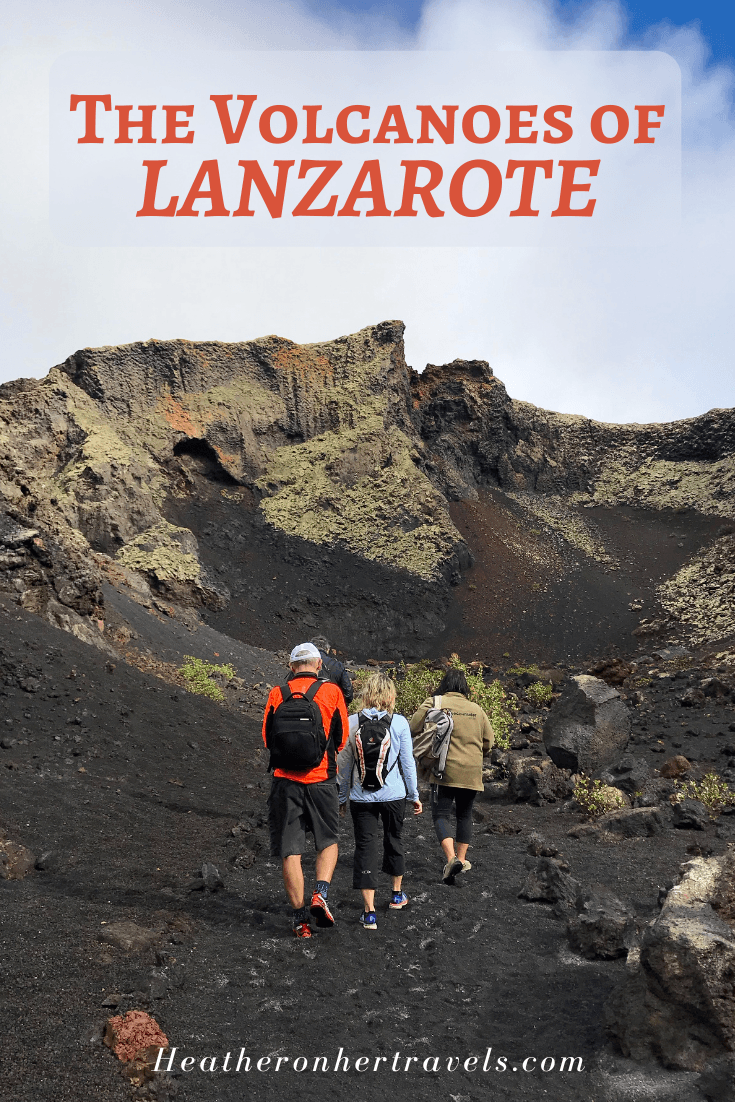The austere, otherworldly landscape of Lanzarote is shaped by hundreds of volcanic cones. Many of them date back to a series of devastating eruptions in the 1730s. For six years from 1730 to 1736, volcanic activity covered 200 square km of fertile farmland with layers of ash and lava.
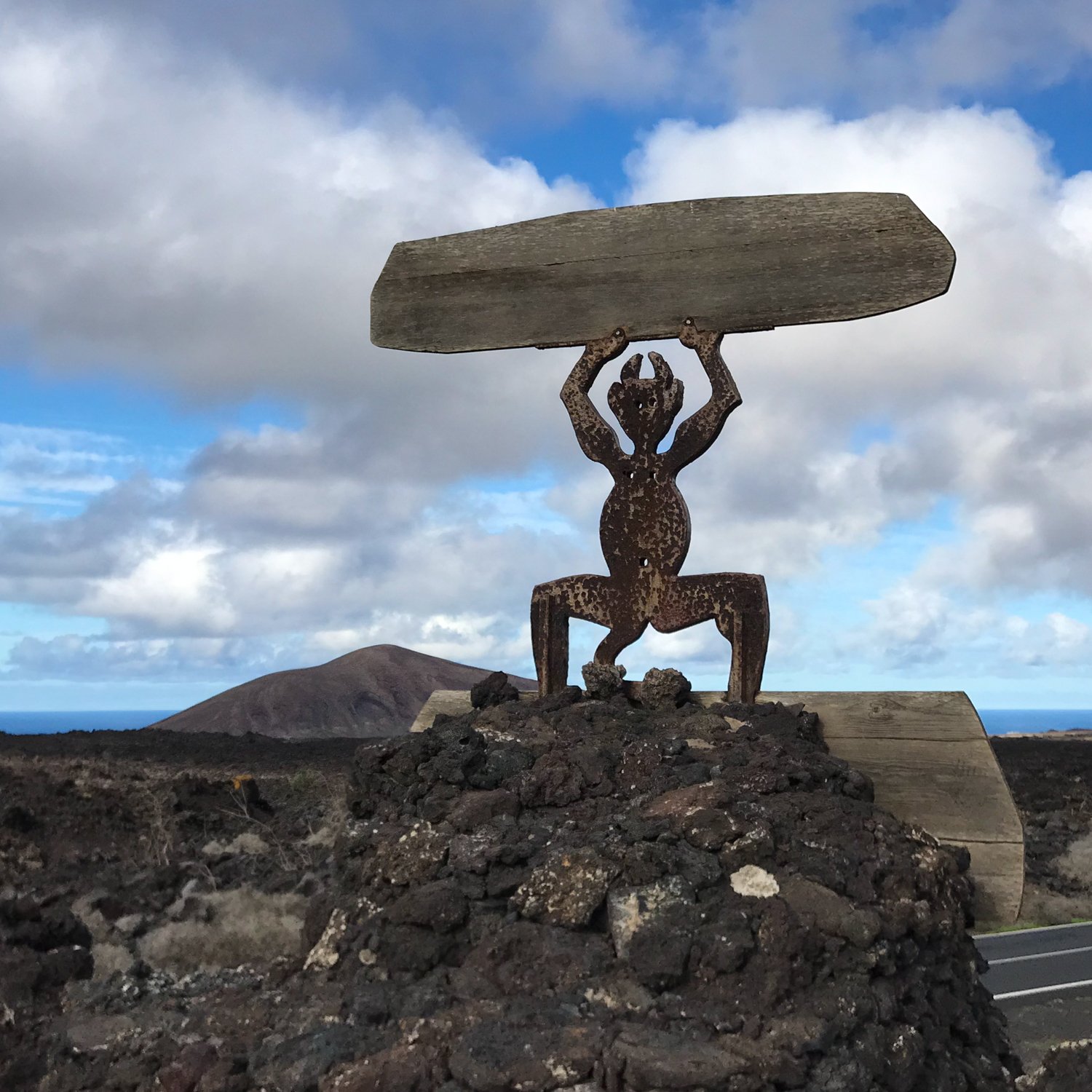
It destroyed up to 20 villages and caused most of the island’s inhabitants to flee to nearby islands. Part of this area now forms the Timanfaya National Park, one of the most popular attractions in Lanzarote.
The parish priest at Yaiza wrote in his diary “a gigantic mountain rose and sunk back into its crater on the same day with such a terrifying sound, covering the island with stones and ashes. The fiery lava streams descended like rivers towards the sea with the ash, rocks and dense smoke making life impossible.”
This article may contain affiliate links that provide commission on purchases you make at no extra cost to you. As an Amazon Associate I earn from qualifying purchases.
Timanfaya National Park
A slice of the surreal moonscape left by the cooling lava was established in 1974 as the Timanfaya National Park. The whole of Lanzarote was declared a UNESCO World Biosphere Reserve in 1993, in recognition of this unique landscape.
Most of the volcanoes in Lanzarote are now dormant, but you can visit the Montañas del Fuego or Fire Mountains within the park. Here you can feel the heat of the volcanic activity at first hand.
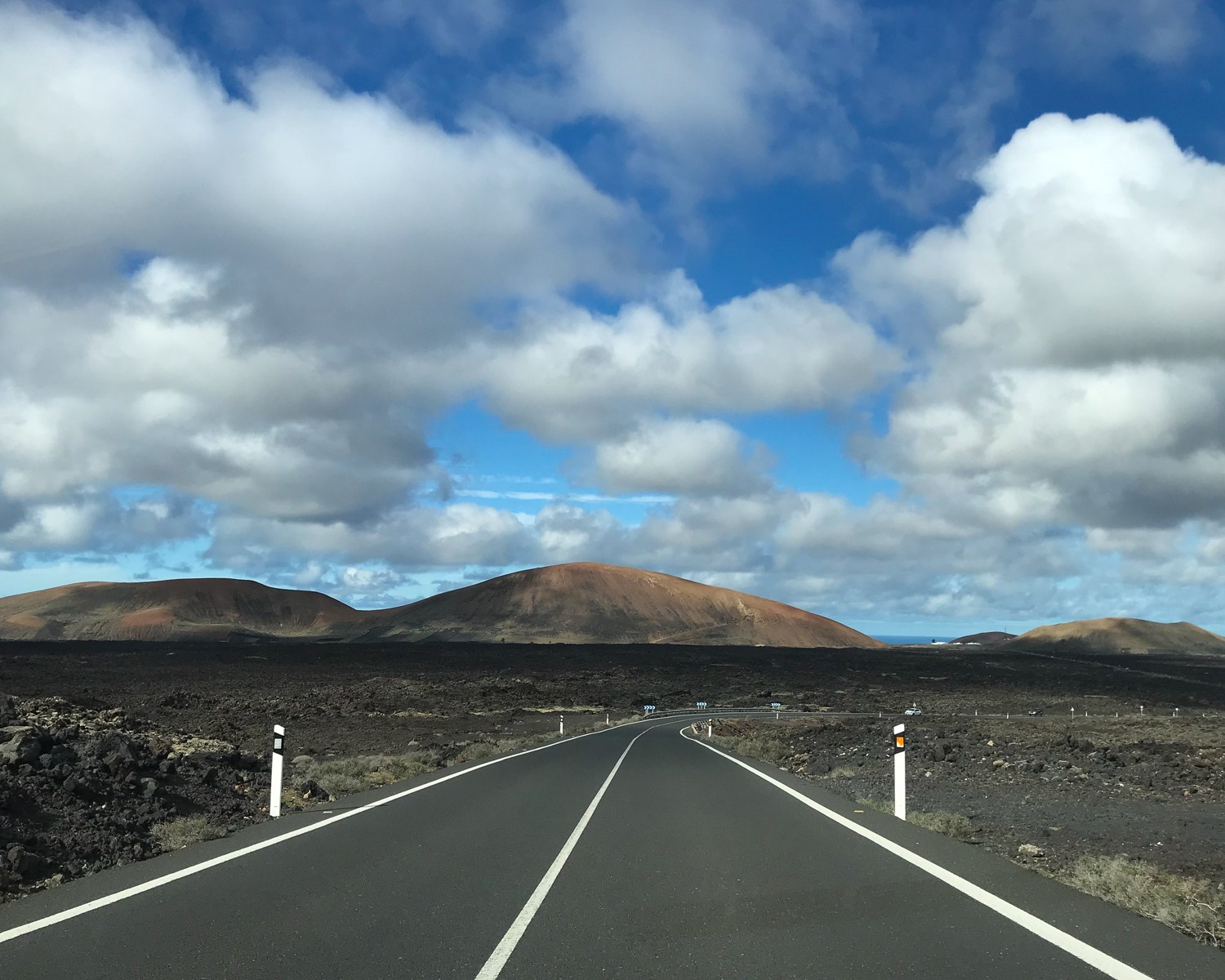
A visit to the Timanfaya National Park is one of the most popular things to do in Lanzarote. There are numerous guided tours that will take you there. However, it’s easy to visit independently, so long as you have a hire car.
Timanfaya National Park covers around 50 square km of the whole volcanic landscape. It’s worth knowing that the less well known Parque Natural de los Volcanes covers a further 100 square km around Timanfaya. This offers even more opportunities to experience the Lanzarote volcanoes.
Montañas del Fuego in Timanfaya National Park
From the ticket booth on the LZ-67 road, a short drive takes you to the start point for the Montañas del Fuego. Leave your car in the car park and take one of the coaches waiting to take you on the tour that’s included with your ticket. Cost of the ticket is €12 per adult payable at the ticket booth by the main road.
As far as the eye can see are the lava fields and volcanoes that were created in the eruptions of the 1730s. These eruptions have created a lunar landscape of rich brown and copper red.
Through this has been carved a single track road called the Ruta de los Volcanes. This road makes a loop through the national park with striking views and occasional steep drops.
Tip: If you plan to do a lot of sightseeing, you can get a joint ticket from CACT Lanzarote which covers to Montanas del Fuego and 5 other attractions for €35.
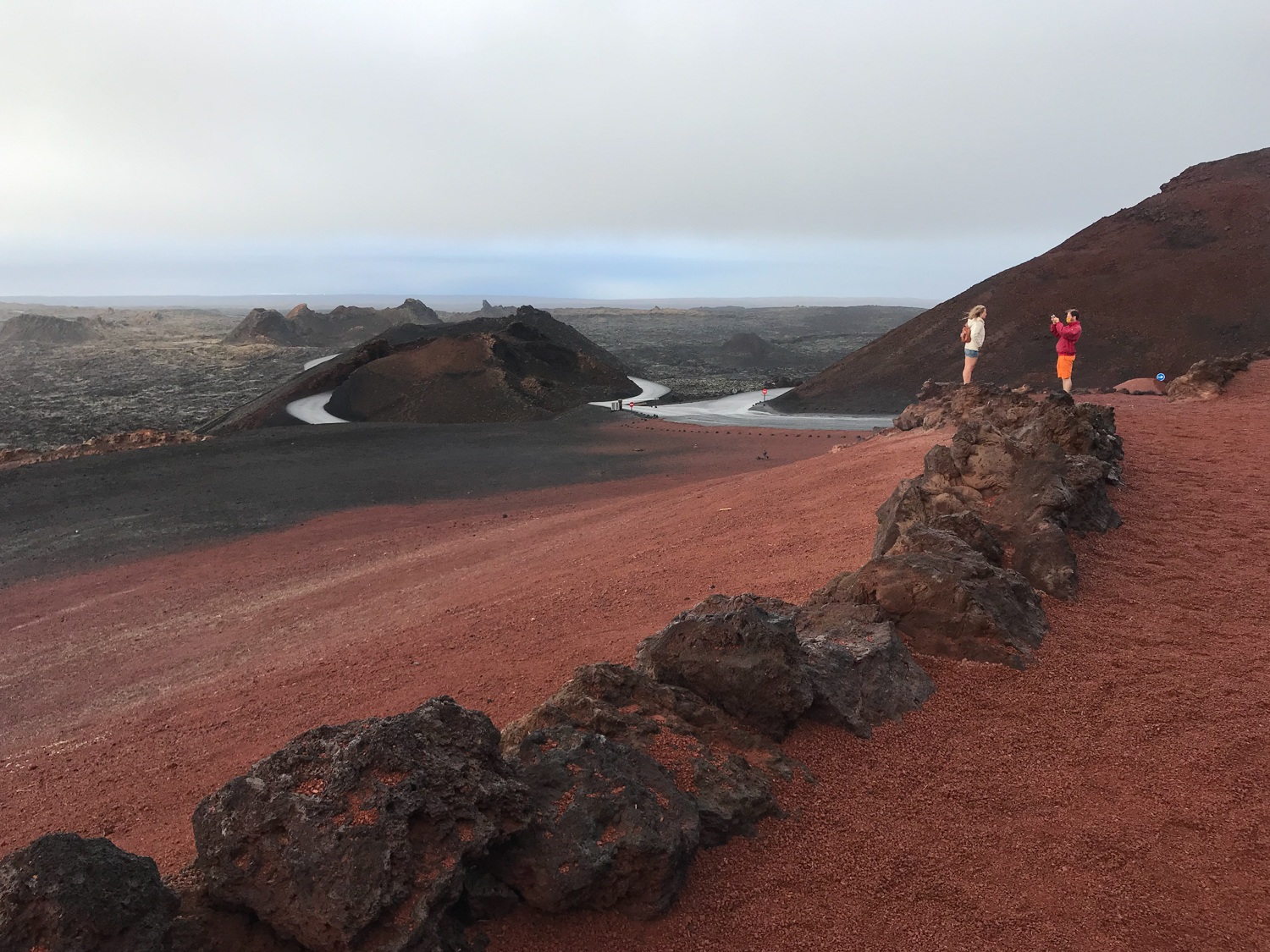
Discover why Lanzarote is a top winter sun destination in Europe
The coach tour on the Ruta de los Volcanes
You can’t walk or drive the Ruta de los Volcanes in your own car. The tour is in a standard size coach, which does have some limitations. Although there was an interesting recorded commentary played in several languages, the only opportunities for photos are through the coach windows.
We had a couple of quick photo stops to take photos from the coach doorway, but were not allowed to get out. We found there were better photo opportunities once we had returned to the car park from the terraces below the El Diablo restaurant.
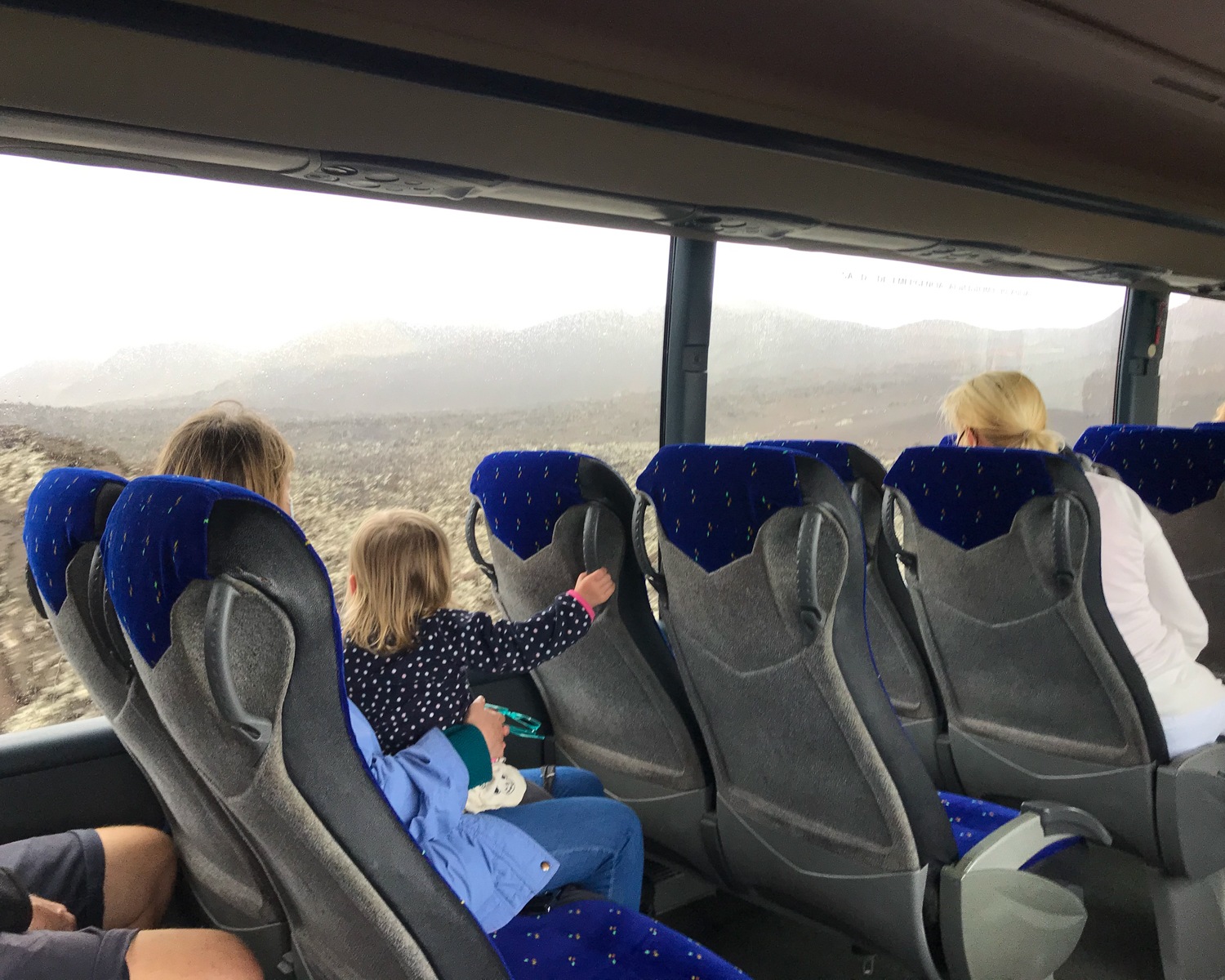
Tip: As time is limited, if you want to take photos, try to sit close to the coach doorway so that you are first in the queue to take photos.

Timanfaya – Geothermal demonstrations
The Montañas del Fuego or Mountains of Fire, are named after the location at Islote de Hilario which still has some volcanic activity. On finishing the coach tour, we were directed to the terrace below the El Diablo restaurant to get a flavour of this at first hand.
The red gravel on which we stood was warm to touch. Through a hole in the earth, our guide demonstrated that the hot magma was not far below. The few branches of brushwood that were tossed down burst into flames in the heat.
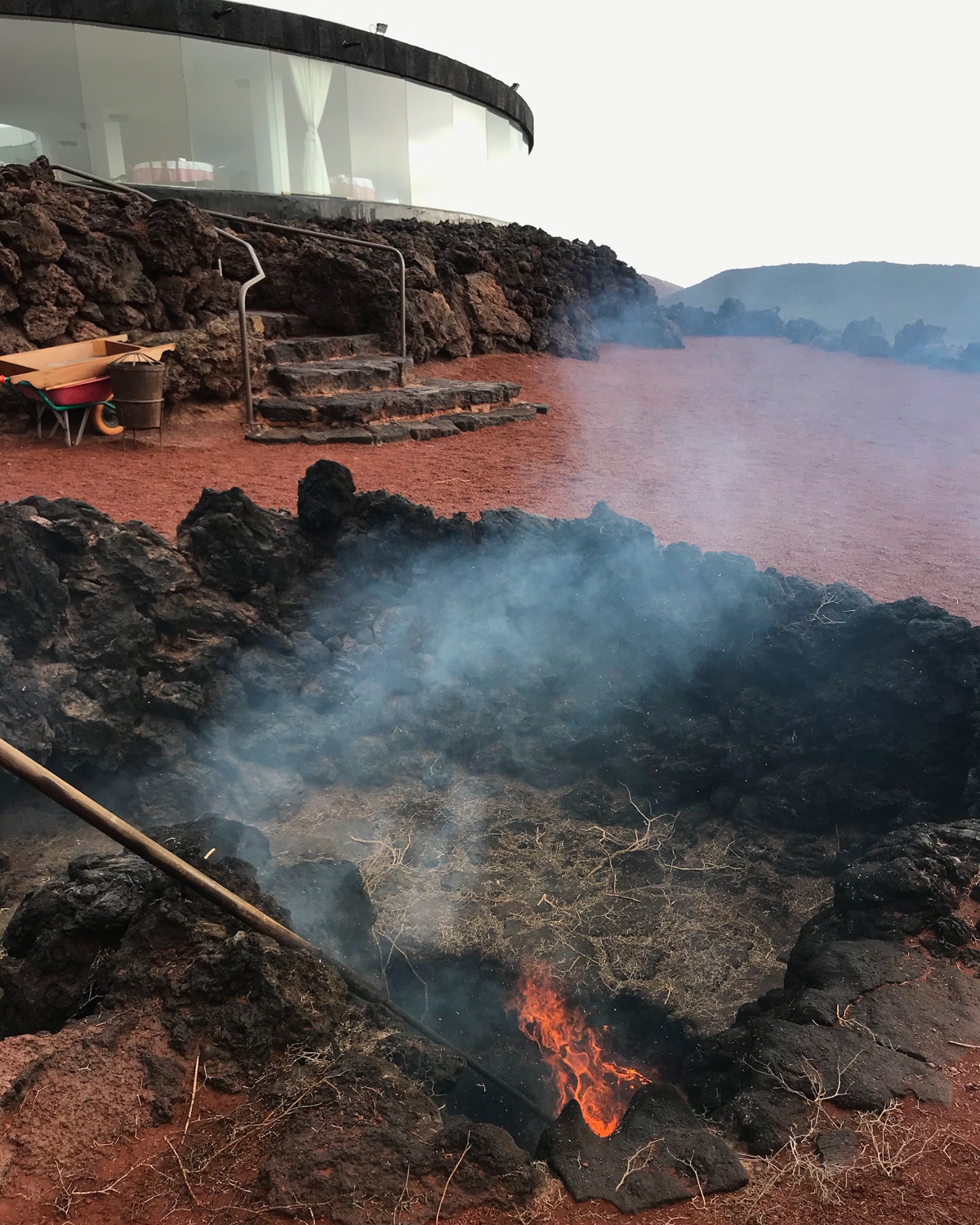
Next the guide demonstrated a geyser effect by pouring a bucket of water into a hole in the ground which trickles down to the hot volcanic rock. Stand well back and a few seconds later a geyser of steam erupted high into the air before subsiding again – impressive!
If you don’t have a car you may want to book this half day tour that includes the camel ride and tour of the Montañas del Fuego.
Timanfaya – El Diablo restaurant
The El Diablo restaurant can be visited before or after the tour. Here the volcanic heat is put to good use in a natural barbeque created by a deep pit. Over this a grill is placed, to cook chicken and other meats.
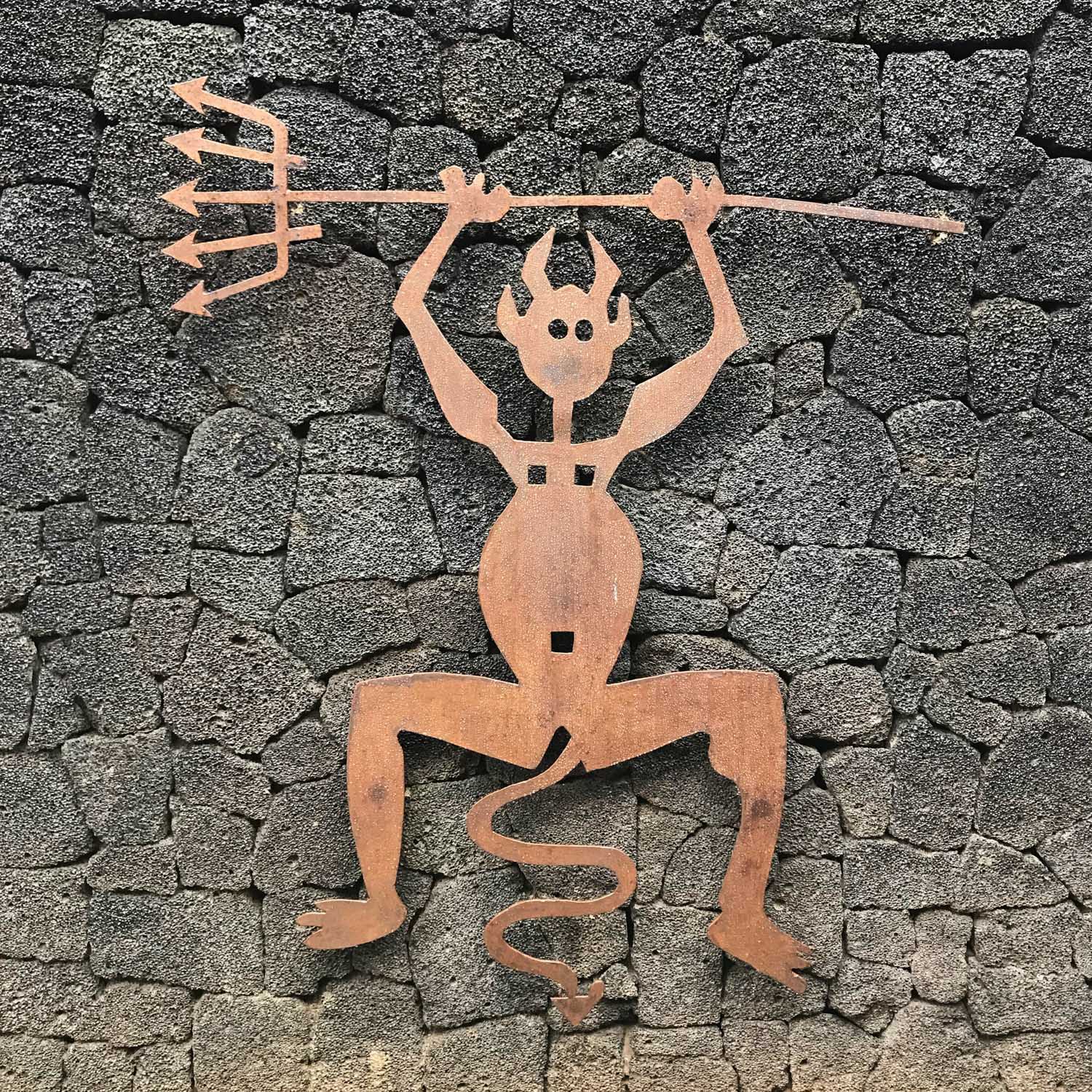
The El Diablo restaurant was designed by Lanzarote artist, Cesar Manrique. It has a circular shape with wrap around windows that offer panoramic views over the volcanic landscape.
The restaurant offers a broad menu and a cafeteria for sandwiches. If you stop for lunch there it’s worth trying the grilled items that are cooked over the volcanic pit, if only for the sheer novelty value.
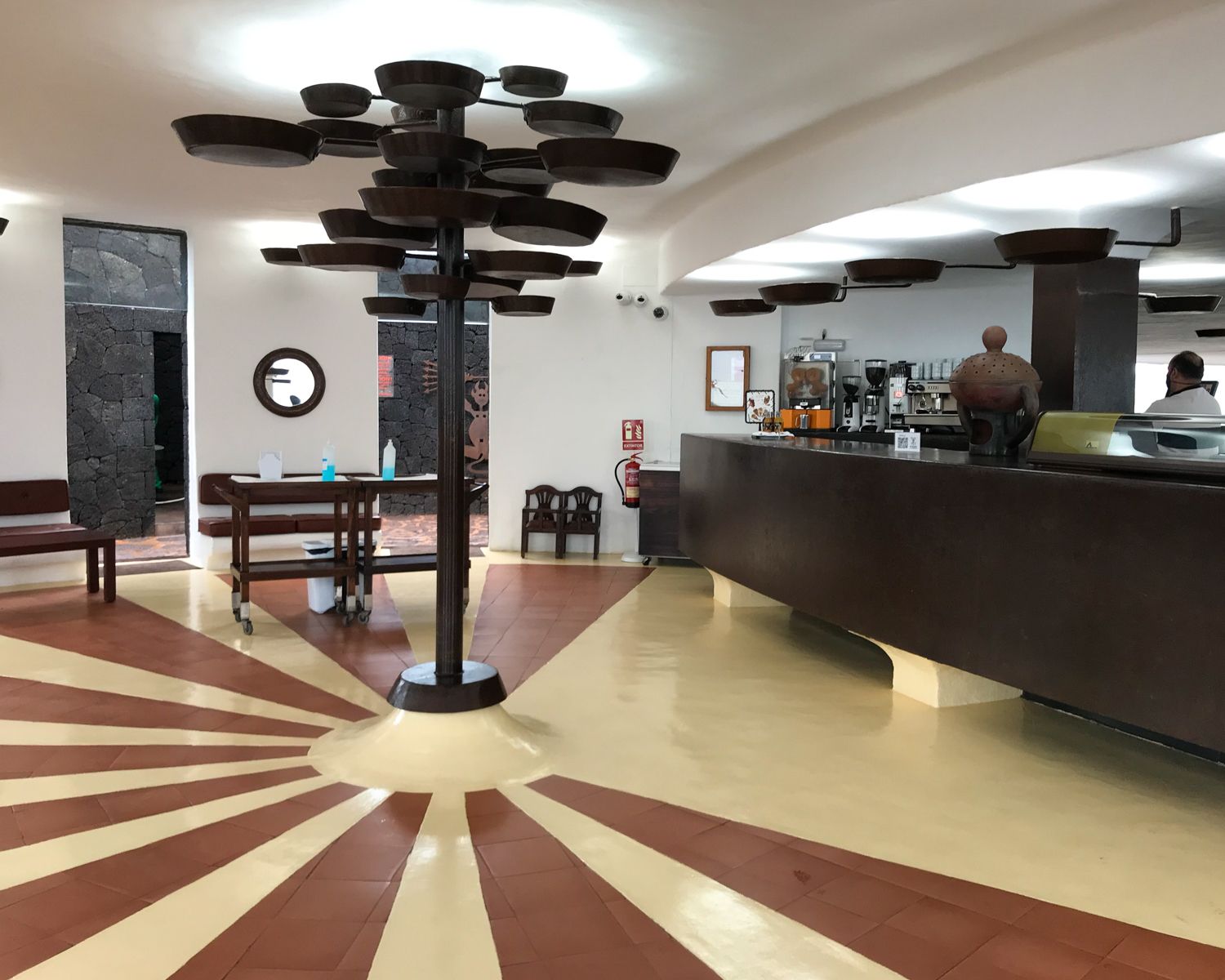
Timanfaya – Take a camel ride
A short drive in the direction of Yaiza brings you to the Echadero de Camellos or camel station. A train of camels is waiting here to take visitors on a ride along a well worn track that runs through the park. The cost is €12 per camel for two people and the ride takes around 20 minutes.
Check out my 7-day itinerary for hiking in La Gomera in the Canary Islands
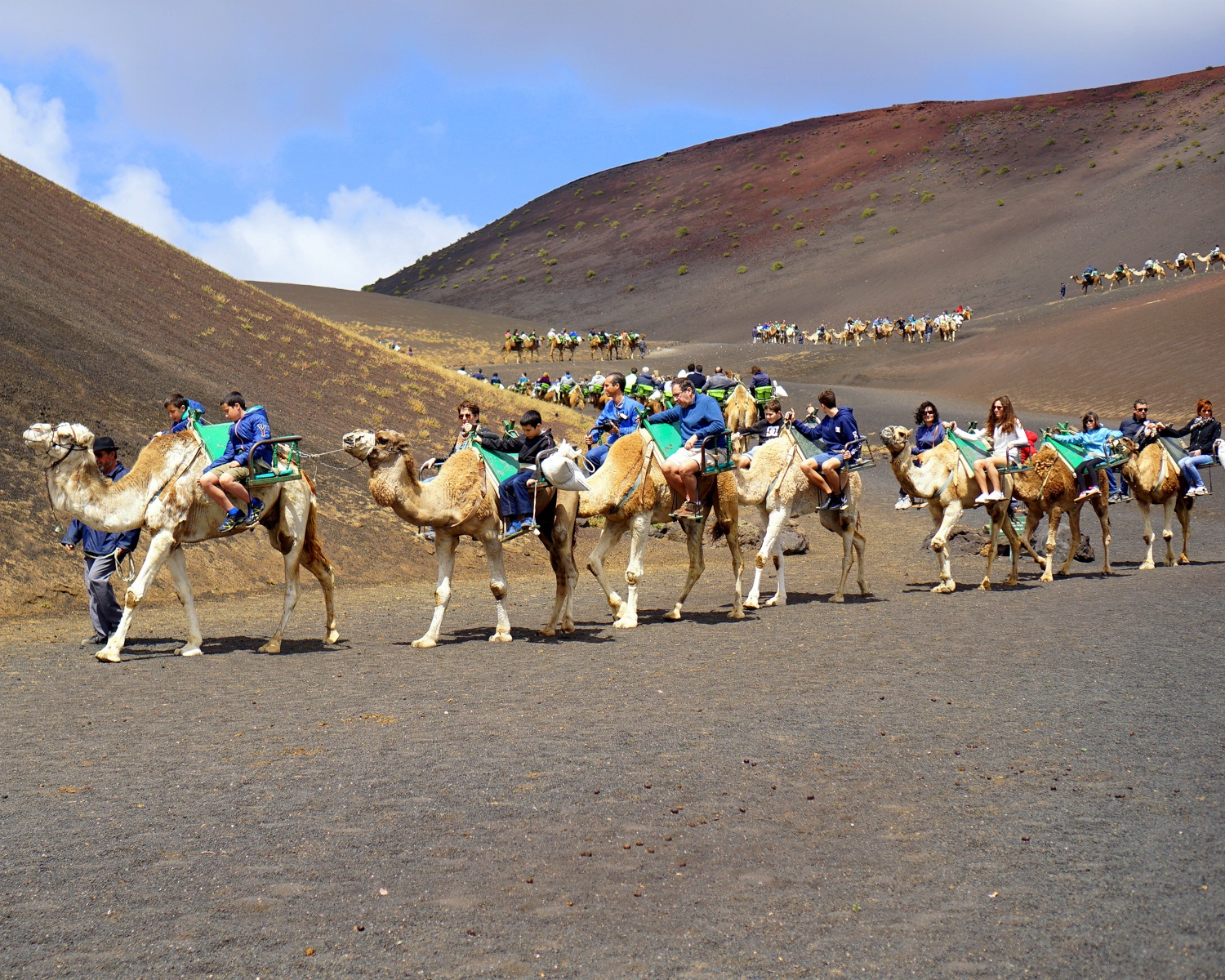
No need to book, just turn up and you can pay the camel handler directly and enjoy (or not) the swaying ride around the park. There is also a small gift shop and museum next to the car park. Here you can see information about the part these camels have played in the agriculture of Lanzarote. Camels can survive on very little water and are traditionally used for ploughing and farm work.
I didn’t have time to take a camel ride myself and am quite cautious about animal tourist attractions. But from what I read, the camels are well looked after. They are a domestic farm animal on Lanzarote so would be used to working on the land. However animal lovers will need to take their own view on whether it’s an activity they want to try.
For a fun day out, we recommend taking a full day tour like this one that includes the Timanfaya National Park as well as many other attractions around Lanzarote.
Timanfaya – the visitor centre
The Timanfaya park visitor centre is in a separate location beside the main road that runs through the park. It’s a short drive from the Montanas del Fuego in the direction of Mancha Blanca.
The centre is free and well worth a visit to learn more about the volcanic activity in Lanzarote and around the world. Walk around the colourful displays, with videos of lava flow and volcano models. The interactive screens display more about how volcanoes affect our planet.
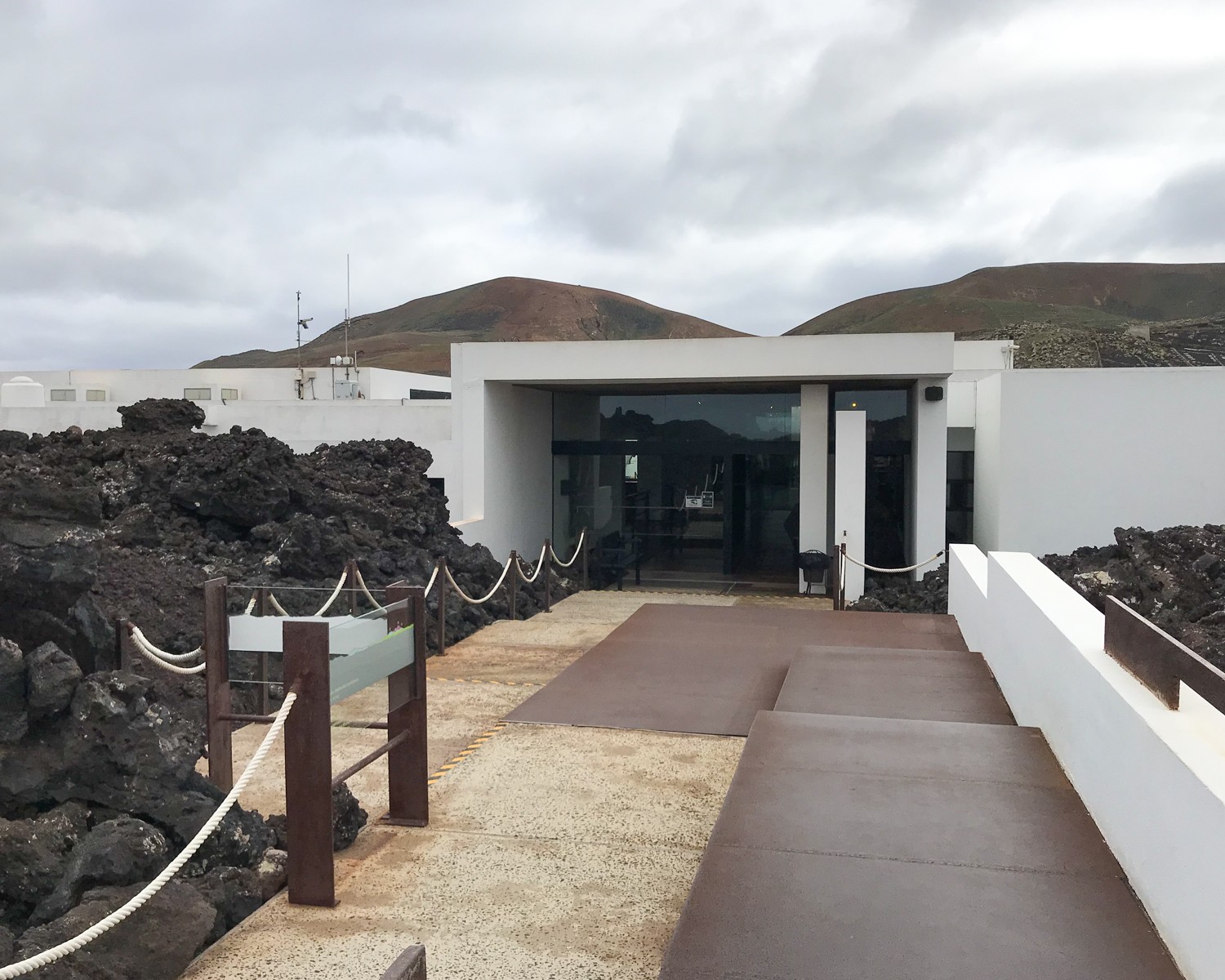
At the back of the centre is a viewing platform. Look out at the black sea of lava that flowed across the fertile farmland, covering numerous villages in the 1730s.
I also happened to be visiting when there was a simulation of the volcanic eruption, which took place in a separate basement room. The rumbling of the eruption, clouds of smoke and coloured lights brought to life the prospect of living close to an erupting volcano. It was a terrifying reality Lanzarote had to endure.
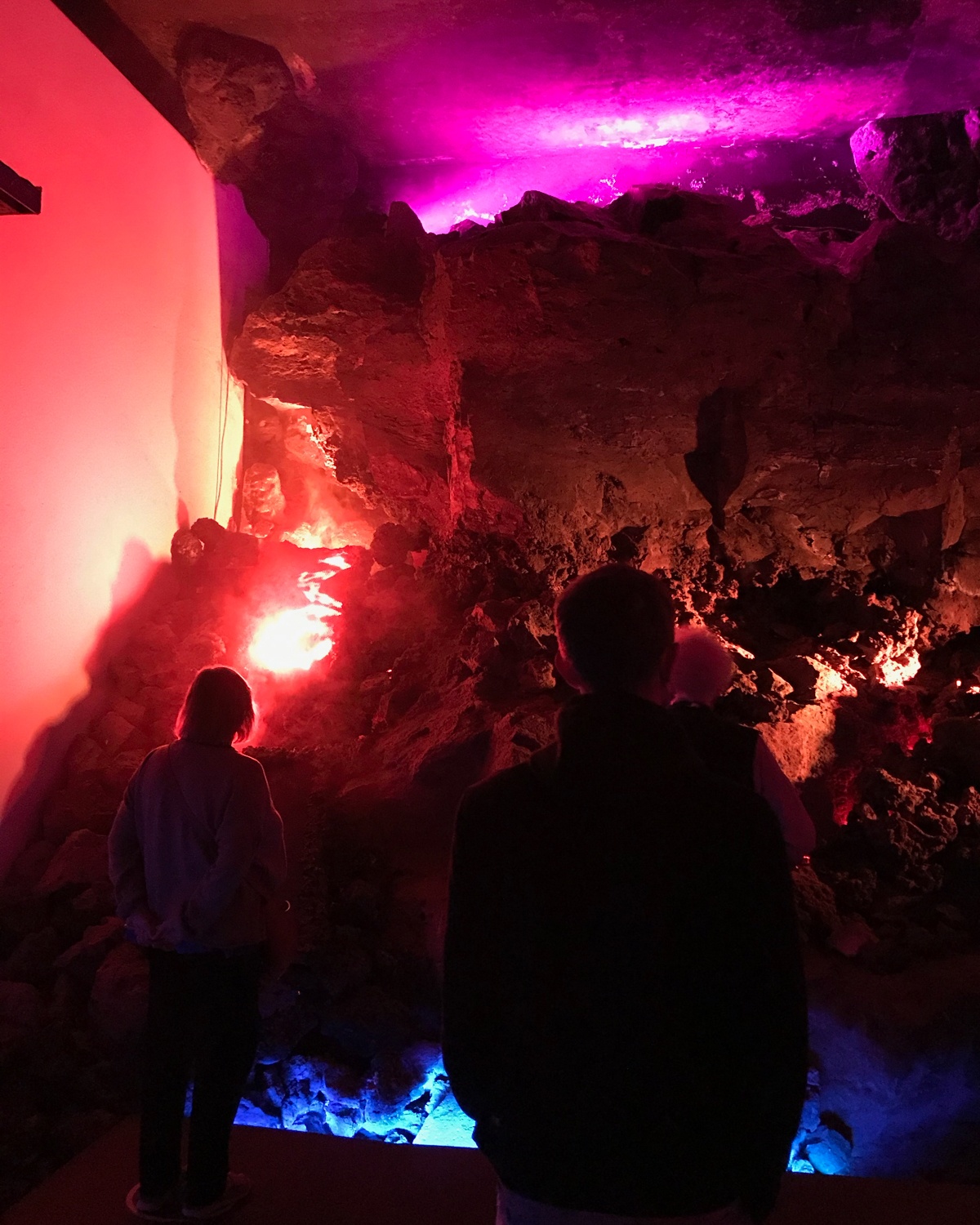
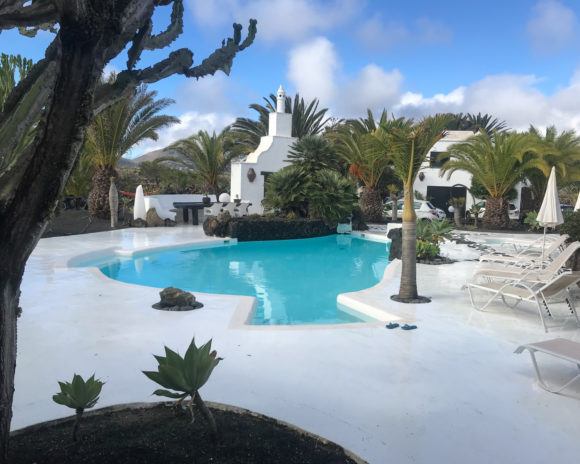
Looking for a place to stay in Lanzarote? We can recommend the boutique vineyard accommodation at Finca Malvasia – read my review
Parque Natural de los Volcanes
Many visitors to Lanzarote head to the Timanfaya National Park. However, this is only one slice of the whole area of volcanic landscape left from past eruptions. Much of the rest is covered by the Parque Natural de los Volcanes. Here there are various trails and information boards that you can visit freely.
Take a volcano tour in Lanzarote
We took a fascinating tour of some of the volcanoes with Eco-insider, a tour company that specialises in small group tours. These tours give you authentic insights into the culture and landscape of Lanzarote.
The benefit of making a tour like this is that we could leave our car behind and travel by land rover. This enabled us to get close to the volcanoes as well as learning all about them from an expert guide.
Check out he volcanic landscape of Teide National Park in Tenerife
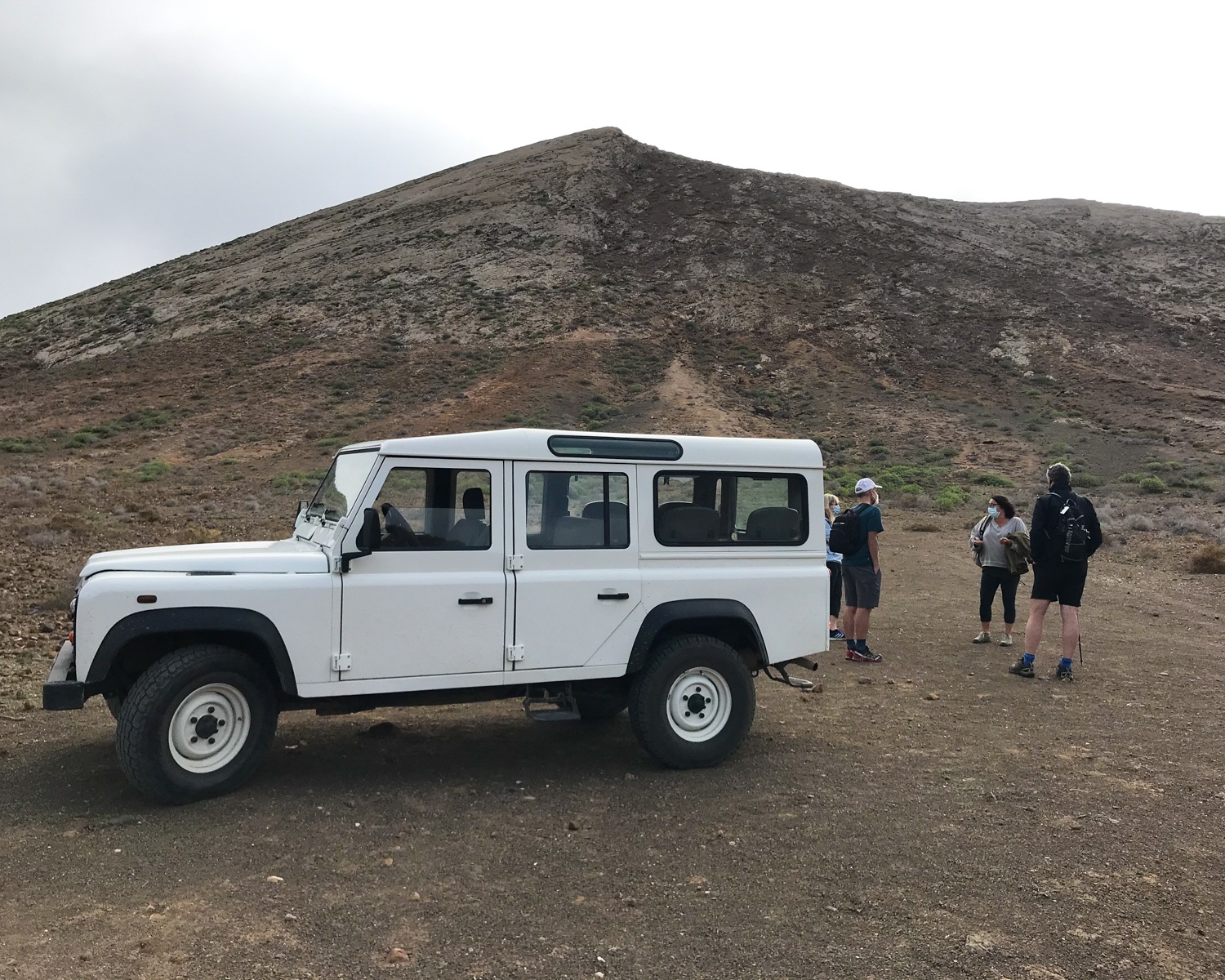
Flora and fauna of the lava fields
Our guide Carmen, from Eco-insider tours is an expert on the flora and fauna of Lanzarote. She brought to life the seemingly barren volcanic landscape, explaining that it is far from dead.
Most plants here are annual and they are adapted to the lack of rain with techniques for conserving water. They only break into leaf or bloom when there has been a shower of rain.

The green lichen covering the lava fields is a sign that the air is pure and the land has been undisturbed since the eruption. Carmen explained that lichen are the pioneer plants as they grow before anything else. They help to break down the rocks to create soil for other plants to colonise. The lichen can survive where no other plants can, drawing on moisture brought by the trade winds blowing from the north-east.
Among the soft green lichen were patches of Xanthoria parietina. It’s yellow color provided a splash of colour against the grey rocks. The Xanthoria lichen are a sign to hunters that there are animals living nearby, since they thrive on the excrement of birds and animals.
Explore my La Gomera travel guide – transport, accommodation and things to do

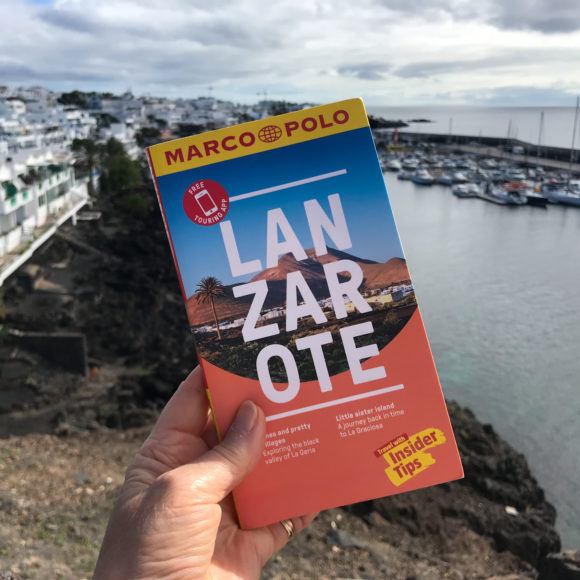
Looking a guidebook for Lanzarote? We used and can recommend the Marco Polo pocket guide
Volcanic crater – Caldera Blanca
Our first stop on the 3 Volcanoes tour was the Caldera Blanca or Montañas Blanca. This is one of the most popular of the volcanoes in Lanzarote to visit. The Caldera Blanca trail runs from Mancha Blanca where the Ruta Volcan Caldera Blanca takes you west out of the town to a car park.
From there you can walk the rest of the trail past the smaller Montana Caldereta to the volcanic cone of Caldera Blanca. The trail is also known as Los Islotes – the islets. The rivers of lava from the 1730s flowed round volcanic cones from earlier eruptions. These older volcanoes stand out like islands in a sea of lava.
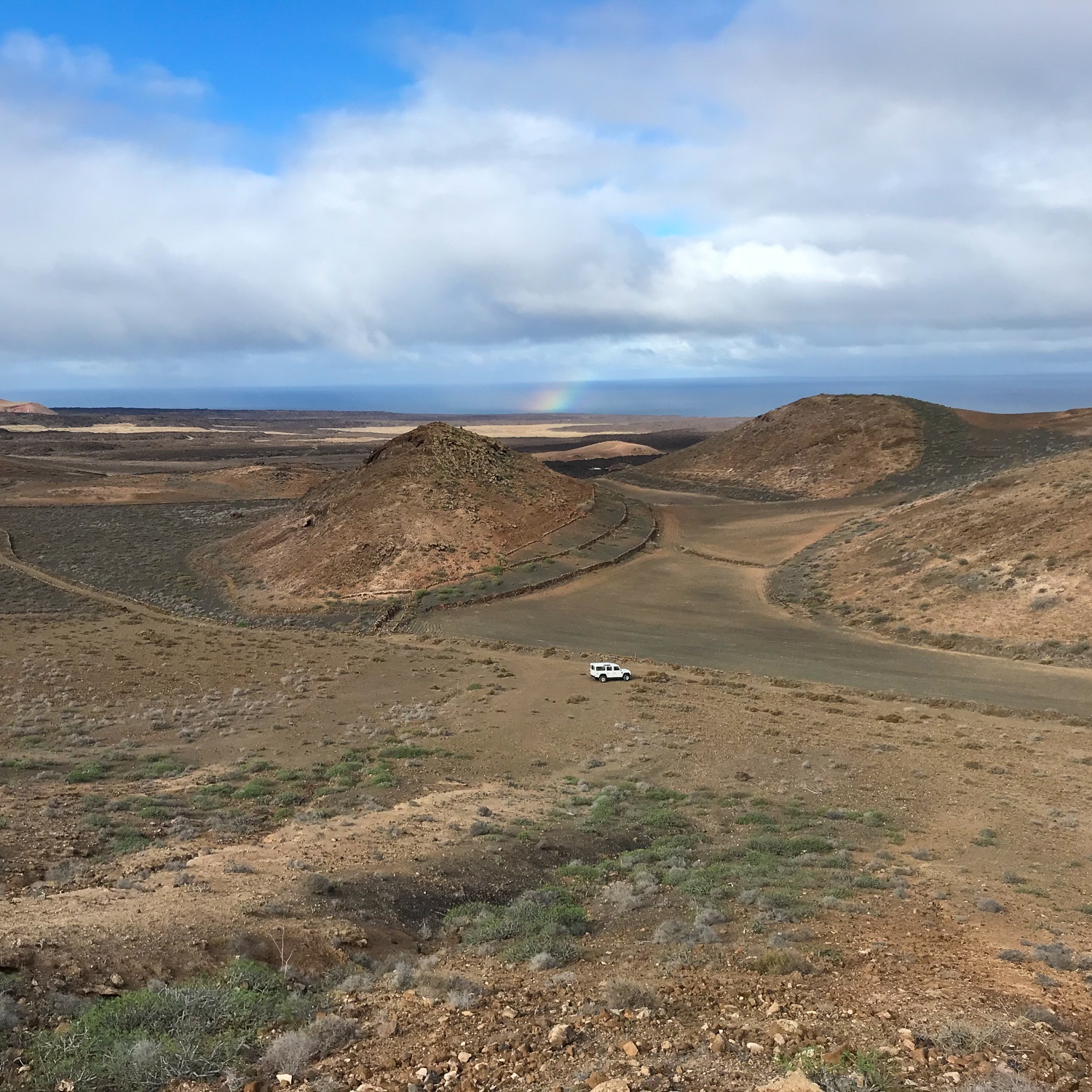
Climbing Caldera Blanca
As part of our 3 volcanos tour with Eco-insider, we could shortcut the long walk and take our landrover along the dirt tracks to park near the base of the volcano. From here we took an easy trail, climbing gently up the side of the montana, looking down on the land rover like a toy car below.
After the recent rains, the dry vegetation on the slopes was springing into life. The green mounds of Euphorbia looked fresh and lush, where they might normally resemble a bunch of dry twigs.
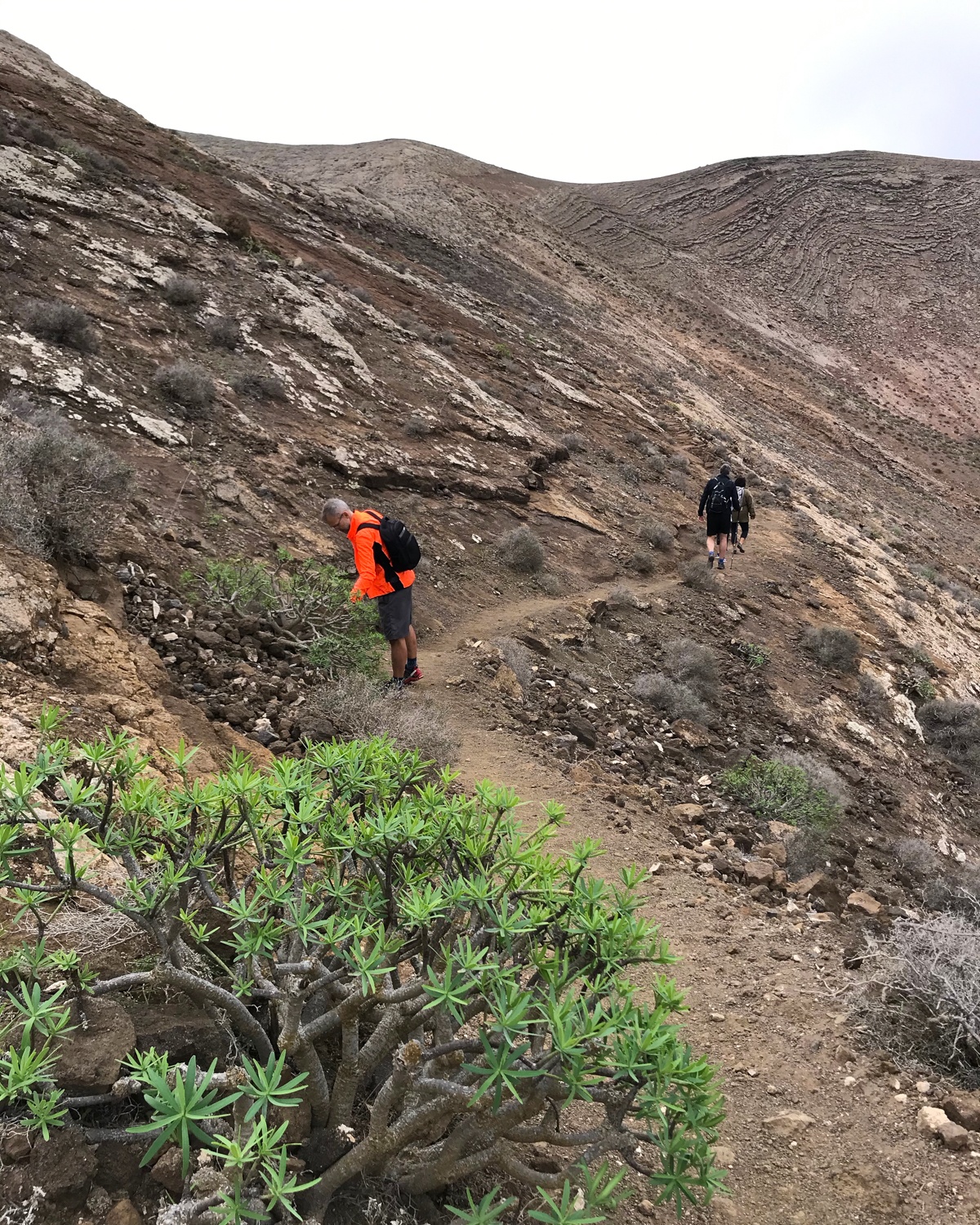
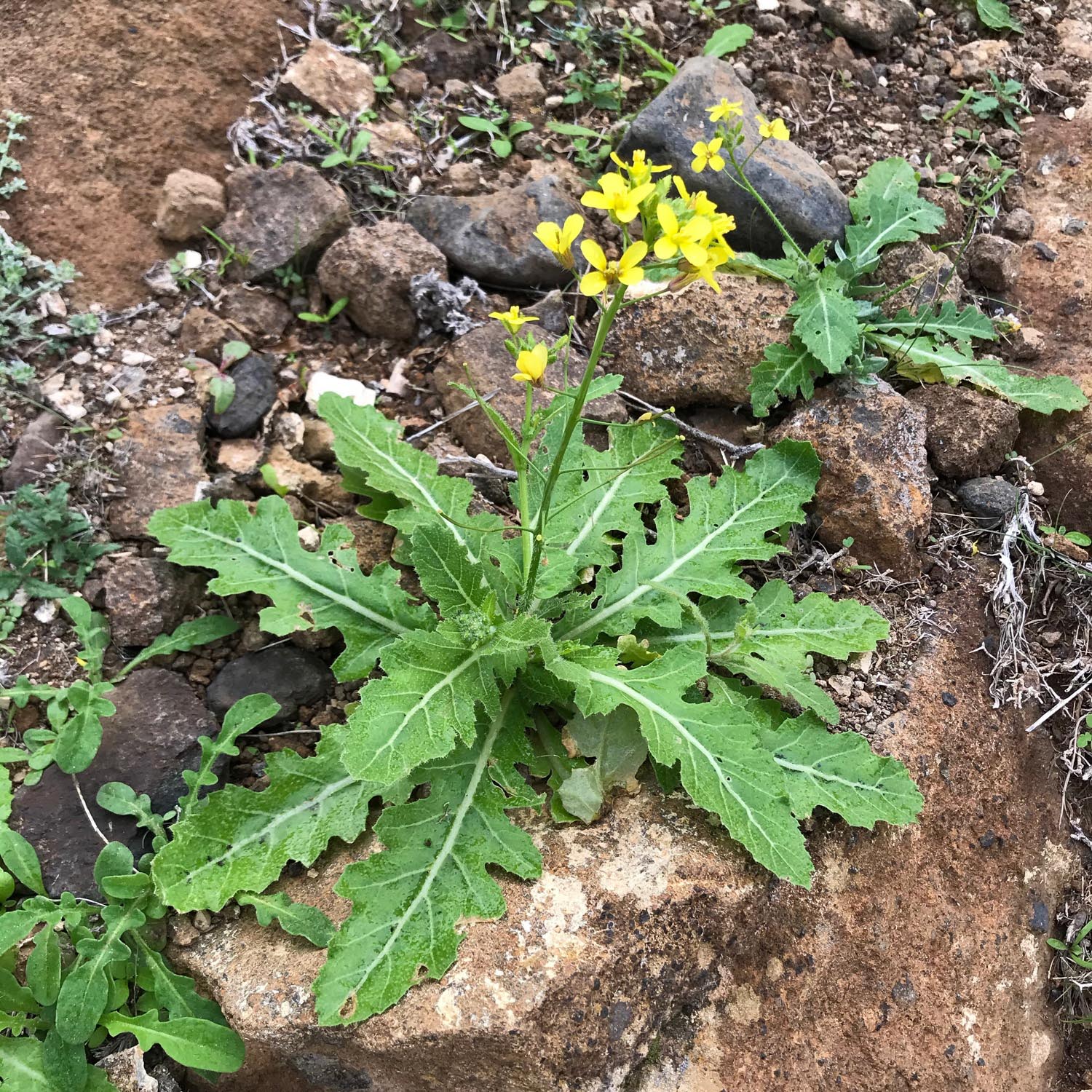
After the short climb we reached the top of the cone of Caldera Blanca. From here we could look down into the crater, with views towards the coast and ocean.
This volcano predates the eruptions of the 1730s when the lava flowed around it. The Blanca name comes from the white caliche material on the sides of the crater, which was used for agriculture in the past.
This was my favourite of the three volcanoes we visited. I loved the views from the top over the Timanfaya volcanic landscape and the sea beyond.
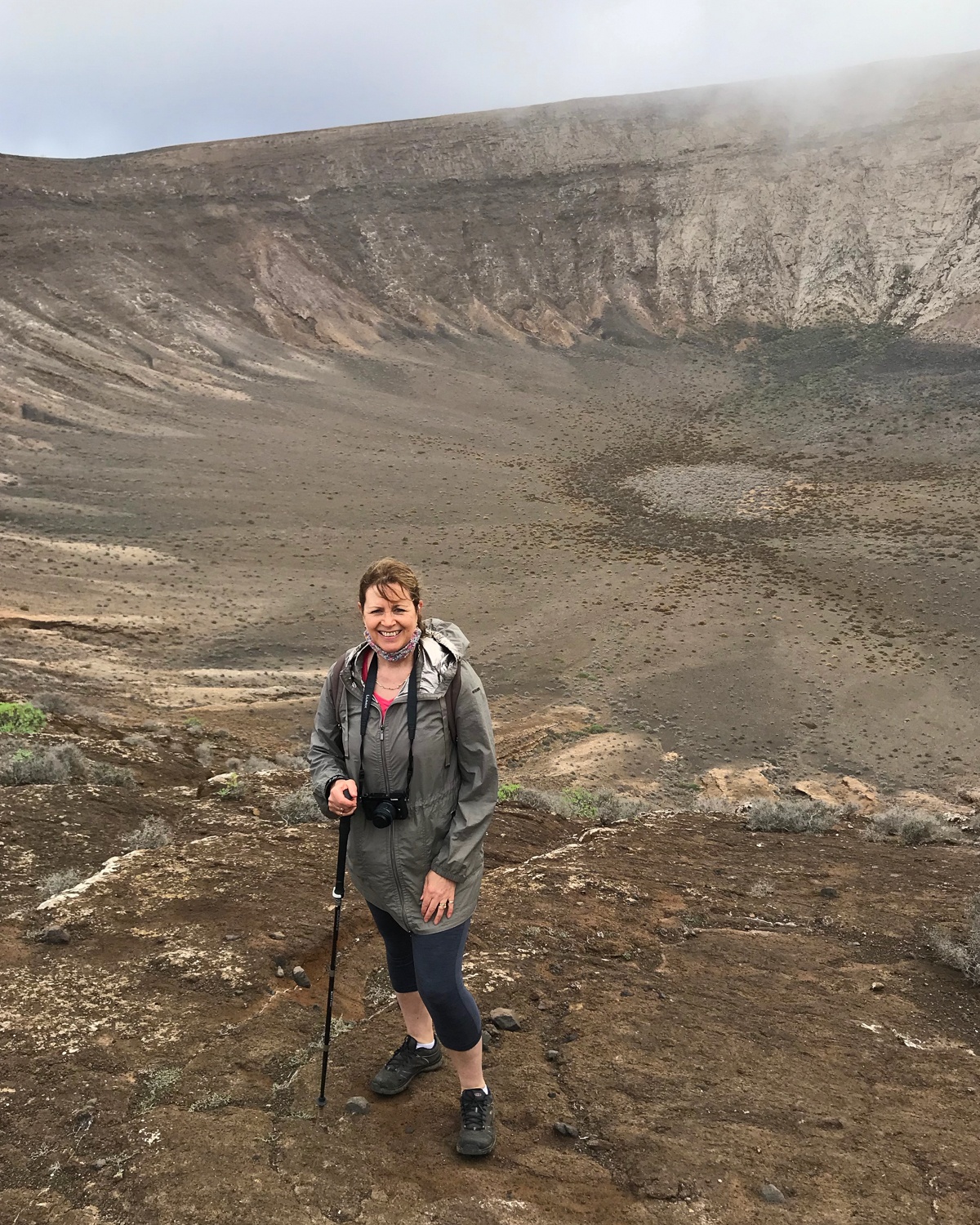
Volcanic bomb – Caldera Colorada
Our next stop was Montana Colorada – also known as Caldera Colorada. Here there is an easy, circular route, although you are not permitted to climb to the top of the volcanic hill. This volcano was one of the last to erupt in 1736 and makes a relatively low mound. This is typical of a one off eruption that stands above the landscape.

Our focus here was the huge volcanic bomb standing in front of Montana Colorada. It was formed in one of the nearby eruptions that had ejected it from a crater. Carmen explained that experts have concluded it was more likely to have come from some distance away. Then it was carried along on one of the lava flows.
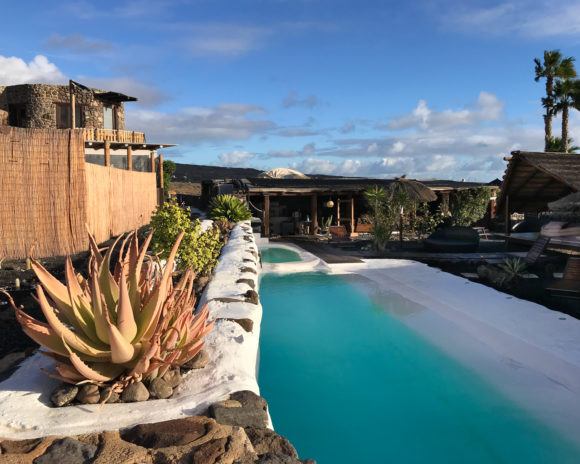
Looking for a place to stay in Lanzarote? We can recommend the eco-village at Finca de Arrieta – read my review
Volcanic crater – Caldera de los Cuervos
Our final visit on the 3 volcanoes tour was to Caldera de los Cuervos. This was formed during the eruptions of the 1730s. It was the first to erupt on 1 September 1730 with a single crater at the heart of the volcano.
The pool of lava eventually ruptured the crater wall on one side. This allowed the lava to flow out into the plain surrounding it, covering some of the nearby hamlets.
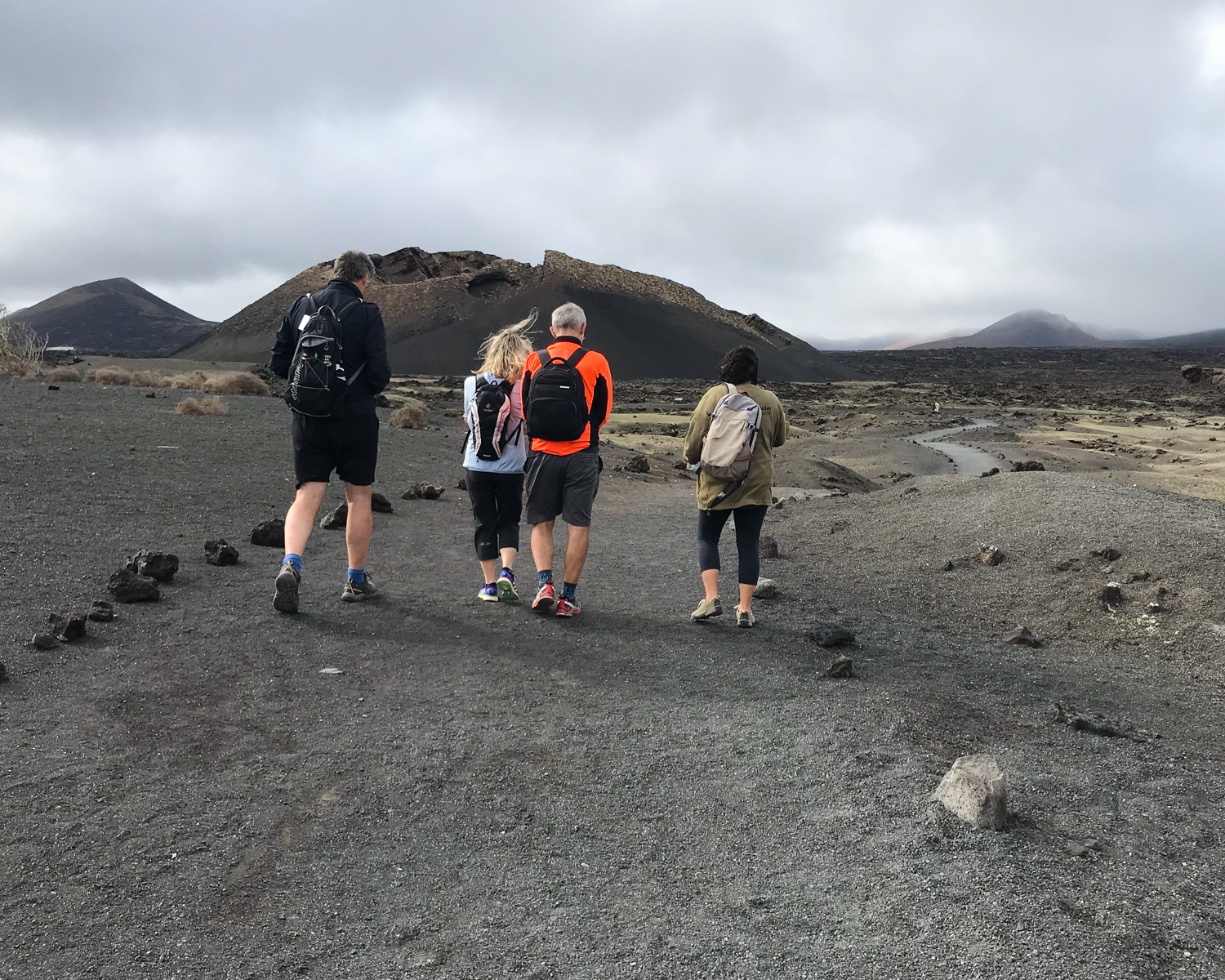
Caldera de los Cuervos is one of the few volcanoes that you can walk right into, to see the different types and colours of volcanic rock. Some of the lava was splattered out from the crater to form molten piles around the top of the cone. In other places it formed jagged heaps where the lava cooled and then was broken up by further flows pushing it forward.
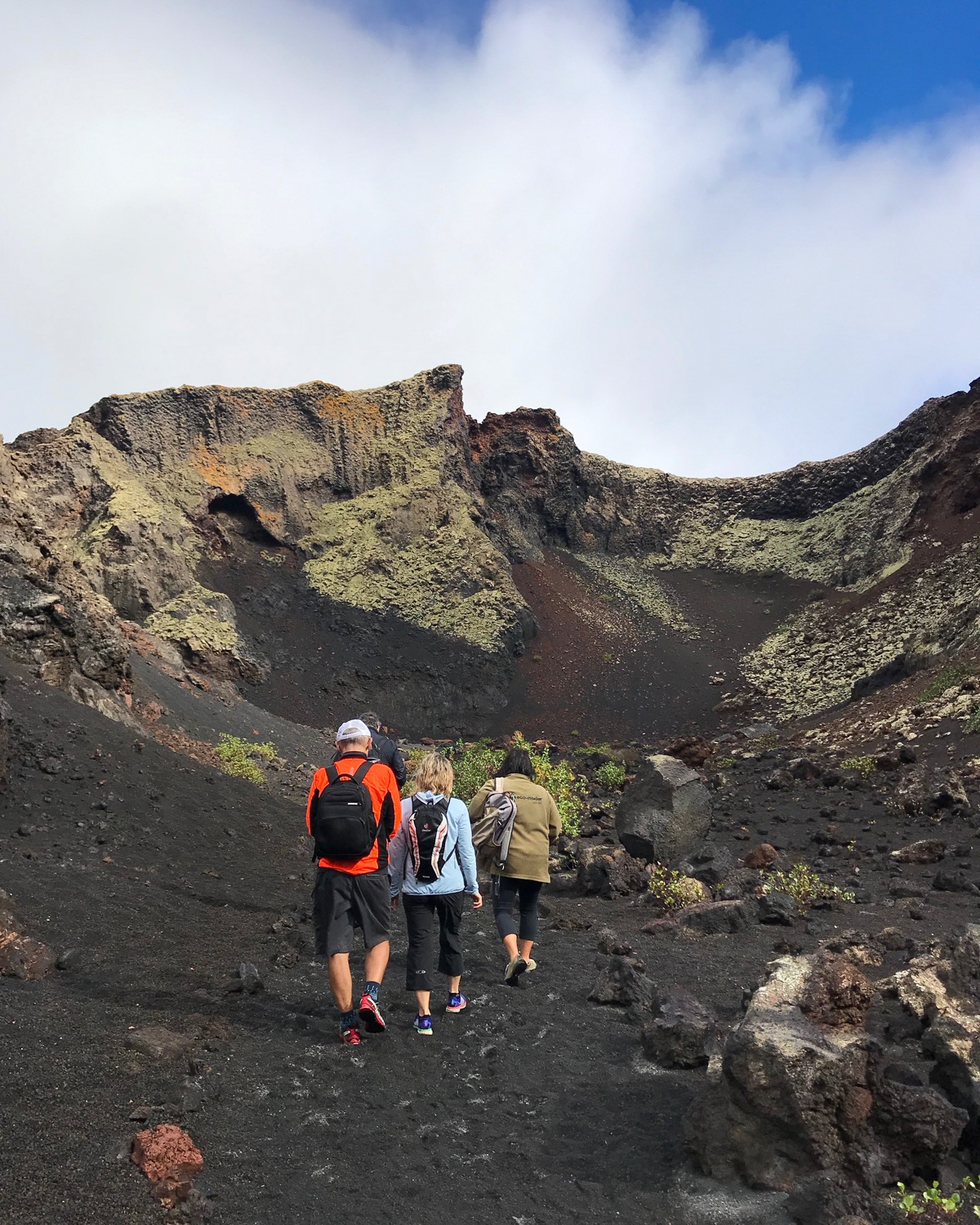
Close to this caldera is Montagna Negra. This volcano is several thousands of years old and pre-dates the 1730s eruptions. During the Timanfaya eruptions, older volcanoes such as this became covered with volcanic material, giving it the black colour that gives it its name.
Taking a volcano tour in Lanzarote
We can highly recommend taking a volcano tour in Lanzarote, such as the 3 Volcanoes tour we took with Eco-insider. The volcanic landscape is such a unique part of this island and we learned so much more by exploring it with the insights of a guide. Carmen was able to bring alive the history and geology of what we were seeing.
Take a volcano walk in Lanzarote
Although you can’t hike within most of the Timanfaya National Park, there are a few hiking trails among the volcanic area of Lanzarote. If you are a serious hiker, it’s best to use a guidebook as some paths may be visible but forbidden. In general you need to stick to the obvious trails. For most of the trails you will need a hire car to get you to the start of the trail.
Caldera Blanca / Montana Blanca – Within the Parque Natural de los Volcanes, the Ruta Volcan Caldera Blanca is accessed from the small town of Mancha Blanca. Drive west from the town, turning off the LZ67 until you find the Car Park for the Volcanic trail. The trail leads through the badlands or malpais as the lava fields are known. It passes the smaller Caldereta, before you reach Caldera Blanca. You can climb to the top as we did and walk right around the rim of the crater for views towards the coast. The round trip can be completed in a few hours.
Tremesana Route – This trail can only be walked with a guide, as it passes through the Timanfaya National Park. Registration must be made online in advance. If you enquire at the Timanfaya Park visitor centre, you may be able to join a group at short notice if there is space. The guided walk is free and runs four times a week, taking around 3 hours. More information here.
More volcano walks
Montana Colorada / Caldera Colorada – This easy trail runs around the volcanic cone but you are not allowed to climb up it. Beside the trail you’ll find the huge volcanic bomb which is worth a short detour. For this trail take the LZ-56 that runs south from La Mancha and stop at the car park on the eastern side of the road.
Caldera de los Cuervos / Volcan el Cuervo – Take the LZ56 that runs south from La Mancha. There’s a car park on the west side of the road, a little further than the car park for Montana Colorada. From here you can take the well marked trail that leads towards the crater and runs right inside. Then go around the crater to get back to the car park.
The route from El Golfo to Playa El Paso runs along the rugged coast on the edge of the Timanfaya lava field. You can park in El Golfo at the end of the village by the children’s playground. Be sure to stick to the path as the lava is jagged and there are deep lava bubbles that you could fall into. You can either return by the same route of follow the circular path inland until it skirts back to El Golfo.
Montaña Los Rodeos – This 4 hour walk takes you along a straight dirt track to this high volcanic cone. There’s a trail that runs around the peak and one that takes you up to the top for views over the surrounding area. There is a parking area on the LZ-56 just south of La Mancha.
Plan your trip to Lanzarote
For a comprehensive but compact guidebook covering all you need to know about Lanzarote, I recommend the Lanzarote Marco Polo pocket guide. This is the guidebook that I used while were were there. There’s lots of background information and insider tips on the best things to see. It includes a free touring app with maps to download and use offline.

Looking a guidebook for Lanzarote? We used and can recommend the Marco Polo pocket guide
For guided tours I can recommend two excellent tour companies in Lanzarote;
Wine Tours Lanzarote run regular wine and craft beer tours and are extremely knowledgeable about the food and wine of Lanzarote. We took their most enjoyable wine tour covering three different bodegas which includes pickup from your accommodation. They also have a wine shop for deliveries of Lanzarote wines in the UK and Ireland.
Eco-insider Lanzarote offer a wide range of small group tours with knowledgeable local guides. We took their 3 volcanos tour, but they also run walking tours, birdwatching tours and a full day wine tasting tour.
You can also find some excellent full day tours and boat trips around Lanzarote on Get Your Guide, our recommended tour partner.
Where to stay in Lanzarote
We stayed at two delightful places during our 10 day trip to Lanzarote
- Finca de Arrieta with Lanzarote Retreats. This small eco-village on the northern coast at Arrieta has a number of different villas, stone lodges and yurts with a relaxed and friendly vibe. It’s ideal for independent travellers. You can read my review of Finca de Arrieta here, or for more places to stay check out these Lanzarote hotels.
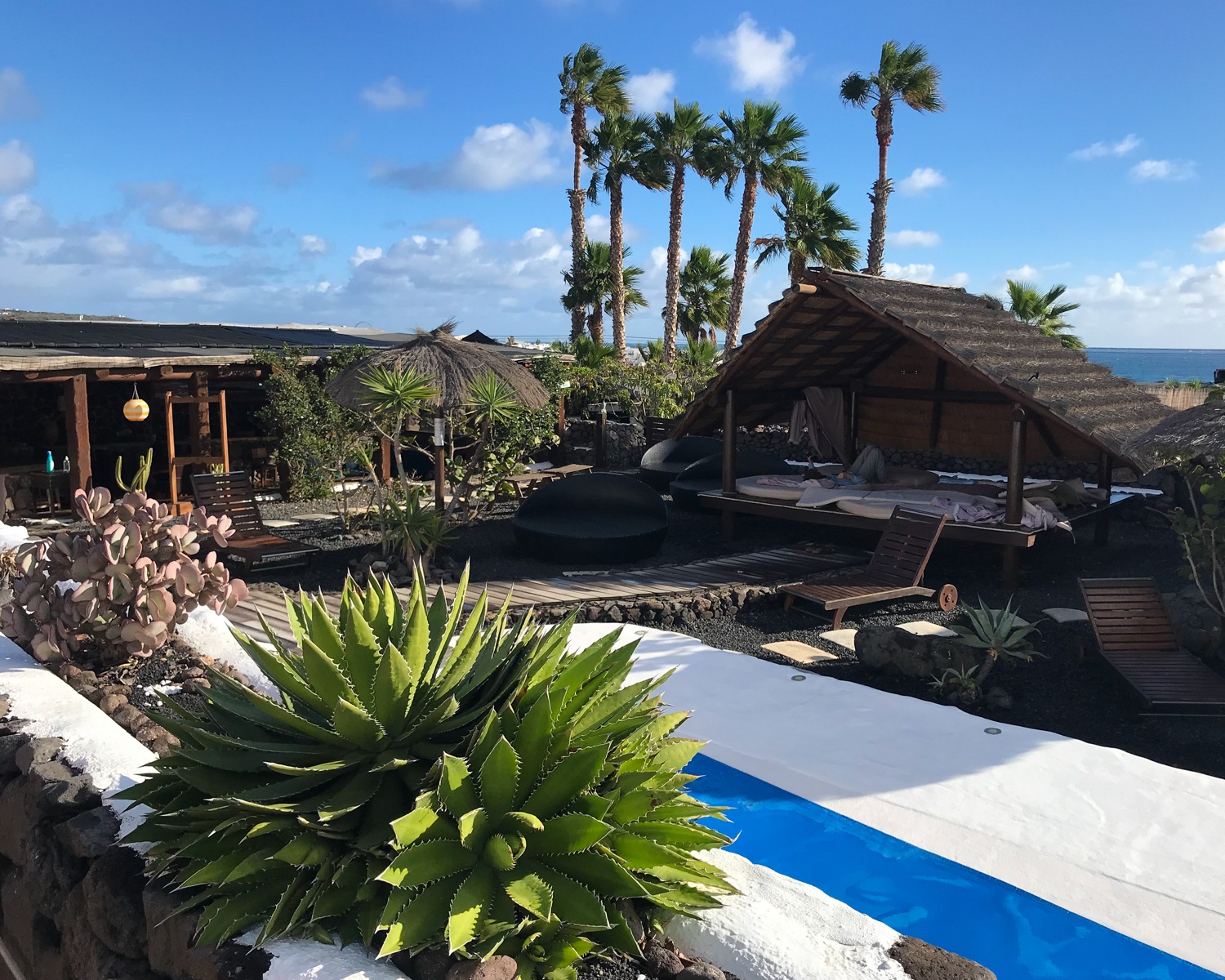
- Finca Malvasia – boutique rural accommodation in the heart of the La Geria wine region, set among a working vineyard. The stylish cottages converted from the old winery are furnished in contemporary style, around a turquoise Cesar Manrique style swimming pool. You can read my review of Finca Malvasia here or for more places to stay check out these hotels in Lanzarote.
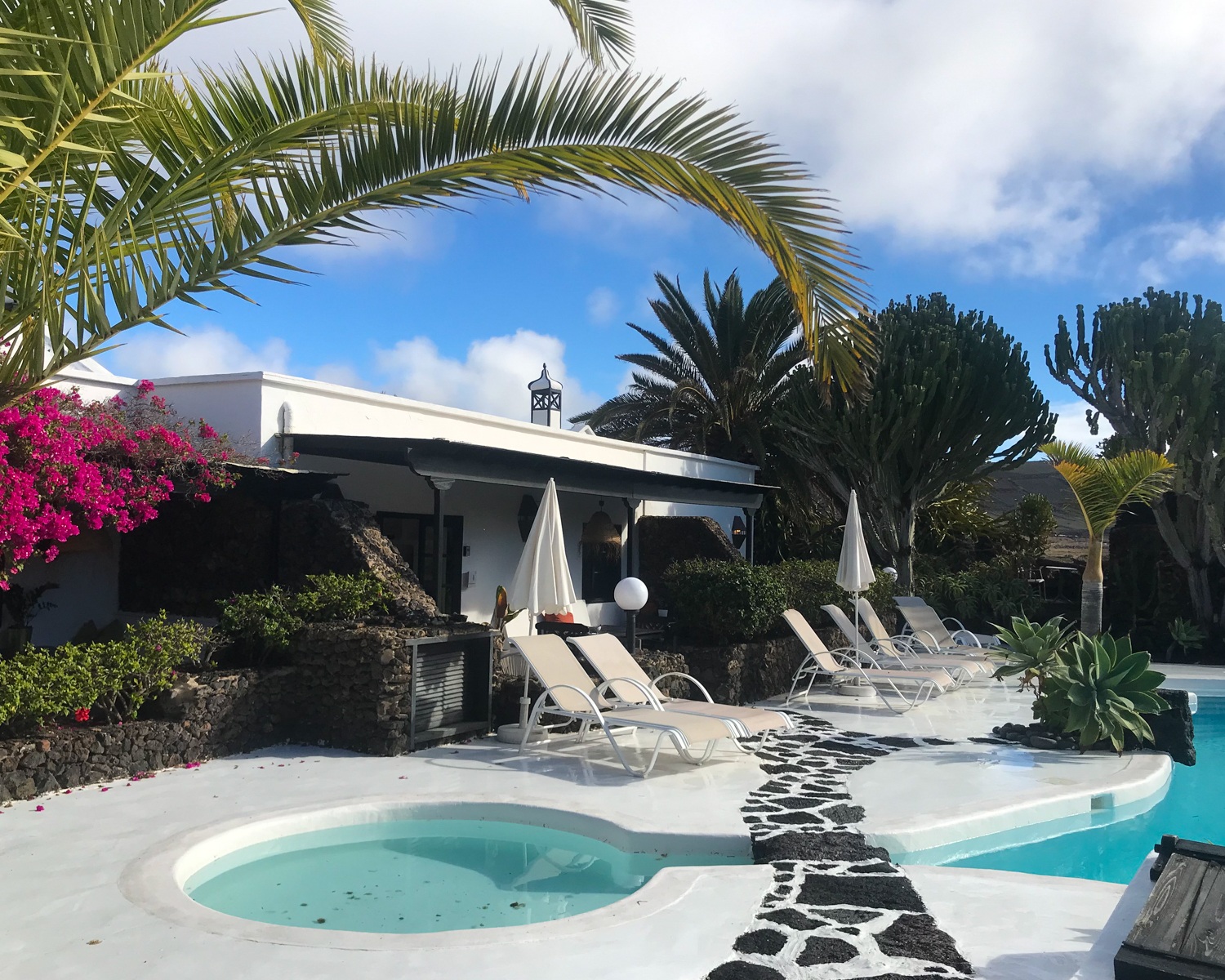
Find more information to plan your visit to Lanzarote on the Turismo Lanzarote website and the Hello Canary Islands website.
Photo Credit: Camels by Iulian Ursu on Flickr
Pin it!
Our 3 volcanoes tour was provided* by Eco-insider and our tickets for the Montañas del Fuego were provided* by Lanzarote Tourism.
* More info on my policies page
This article is originally published at Heatheronhertravels.com

